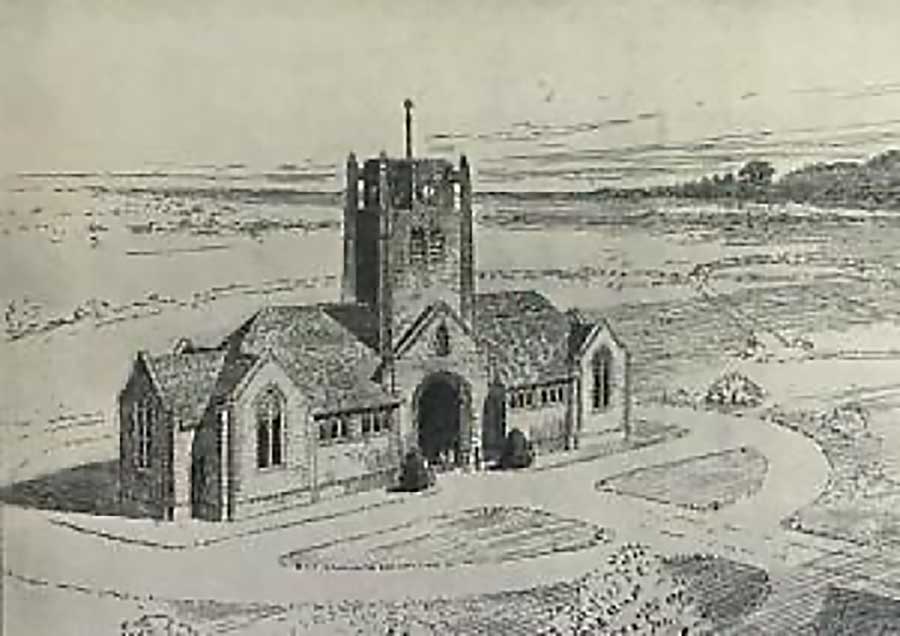
5th October 1908
It was decided by Nottingham City Council to create a large new Burial Ground and Crematorium at Wilford Hill since the current Burial Grounds within the City were becoming overpopulated.
Prior to this, it had already been discussed and decided by the Public Parks and Burial Grounds Committee that more ground was needed.
Prior to 1908 the Council had purchased 48 acres of land at where the site now sits and this also included 3 acres of Reservoir land. Subsequently this left 45 acres for the creation of Cemetery land and Crematorium. The cost implications at the time to purchase the land and provide two Lodges, two Chapels, a Mortuary and toilet facilities was a total of £22,000. This also included the cost of building the crematorium which would be £2670.00.
However at the time, there was a national concern that a “cremation” would not be a popular alternative for “dealing with the dead” as reported in the Nottingham Daily Express of 1908, a Crematorium was not built until a few years later…
3rd January 1928 – A discussion again arose with Nottingham City Council and Mr W Hooley Chairman of the Committee where it was reported that the British Isles had 16 Crematoria and since 1881 there had been 40,000 cremations. The Committee were advised that if they carried out 50 cremations a year as Leicester had done in the previous year, there would be little financial loss.
28th September 1928 – The matter was discussed again about having a Crematorium on the land, due to one not having been built at the time of purchase. The cost for this had risen to £6,000. This again was put before the Public Parks and Burial Grounds Committee.
16th December 1930 – It was reported in the local newspapers that Wilford Hill Crematorium was “Ready”
3rd January 1931 – The Crematorium was ready for opening. However, the Home Office stated that there were new regulations in place as of 28th October 1930 that meant the necessary medical certificate required for cremation could be issued by a wider range of practitioners. This did however stipulate that you could not be a relative of the deceased or a partner of the Doctor who has given the certificate of attendance.
6th January 1931 – After adhering to the Home Office guidelines, Wilford Hill was (again!) now ready for opening.
It was described as:
“The most up to date Indeed. Nottingham has the only oil burning crematorium plant in the country”
The first visual indication of the Crematorium when visiting the site was the Columbarium which faced Nottingham – this was used for placing the urns that contained the deceased’s ashes in as a final resting place.
In the what is now the Main Chapel there was the catafalque; a coffin was placed on here and during the service it was then lowered to a room beneath and conveyed along rails to a chamber in which is it was raised so the cremation could then take place.
To enable the combustion of the coffin, crude oil was then sprayed from a side room which was atomised when it met the air and that is how combustion occurred. The incinerator at the time measured a maximum temperature of 2000°C however temperatures this extreme were not used for cremating.
Once the cremation had taken place the cremated remains would ‘drop’ through a grate into terracotta urns. The ashes were then scattered in the Garden of Rest or placed in the Columbarium.
The cost of a cremation at this time was: –
£3 3s if over 16yrs and lived within the city
£2 2s for those under 16 yrs and lived within the city
For non-city residents the was an added cost of £2 2s
18th July 1938 – It was reported that Wilford Hill’s use of the Crematorium was still low. The following figures were presented regarding its usage year by year
| Year | Amount of Cremations |
| 1931 | 70 |
| 1932 | 74 |
| 1933 | 90 |
| 1934 | 136 |
| 1935 | 125 |
| 1936 | 184 |
| 1937 | 240 |
| 2020 | 1900 |
28th September 1937 – There was a demonstration of organ music held within the chapel. The Committee then went away to deliberate whether the cost of purchase and installation was viable in order to play music during the service.
14th February 1945 – It was reported that the number of cremations taking place had increased by 100 upon the previous year bringing the total to 692 and that an extension of the chapel was required to accommodate the increasing figures.
29th April 1946 – Cremations totalled 4,921 since Wilford Hill Crematorium opened.
1st October 1946 – It was reported that the Garden of Rest was having preliminary works to extend the memorial area.
1992 – The Woodland Walk Memorial & Scatter Garden was created
2012 – The Mercury Abatement System was installed. This was to ensure that the Crematorium met the current legislation (Environmental Act 1990) regarding the release of harmful gases into the atmosphere.
2020 – The use of webcasts (online streaming of services) became more popular due to the limited number of attendees allowed to attend a service due to the COVID Pandemic.
2021 – The music and webcast streaming service were transferred to Obitus allowing families to have a greater choice of music and tributes.
2023 and The Future – Plans for improvements to the Crematorium continues to be underway with renovations to both the Chapels and the Crematory area.
Sources:
Nottingham Newspaper Archives
Nottinghamshire City Council records
www.issuu.com
